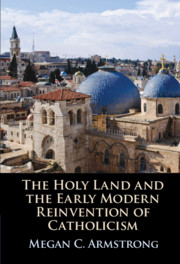Book contents
- The Holy Land and the Early Modern Reinvention of Catholicism
- The Holy Land and the Early Modern Reinvention of Catholicism
- Copyright page
- Dedication
- Contents
- Figures
- Acknowledgements
- Introduction
- 1 A Catholic Gateway to the Holy Land
- 2 Altars and Christian Precedence in the Holy Places
- 3 The Order of the Holy Sepulcher
- 4 France, the Protector of the Holy Places
- 5 The Congregation of the Propaganda Fide
- 6 A Franciscan Holy Land
- Conclusion
- Bibliography
- Index
Conclusion
The Holy Land: Renewal, Revelation, and Reinvention
Published online by Cambridge University Press: 30 April 2021
- The Holy Land and the Early Modern Reinvention of Catholicism
- The Holy Land and the Early Modern Reinvention of Catholicism
- Copyright page
- Dedication
- Contents
- Figures
- Acknowledgements
- Introduction
- 1 A Catholic Gateway to the Holy Land
- 2 Altars and Christian Precedence in the Holy Places
- 3 The Order of the Holy Sepulcher
- 4 France, the Protector of the Holy Places
- 5 The Congregation of the Propaganda Fide
- 6 A Franciscan Holy Land
- Conclusion
- Bibliography
- Index
Summary
The year 1700, which marks the end of this investigation, did usher in some notable changes in the life of the Custody. The death of the last Spanish Habsburg monarch in November saw the throne transfer to the Bourbon line, signaling the coming end to an imperial rivalry that had raged in the Custody as well as other global arenas for over a century. While France would remain an important ally of the Custody at the Ottoman Porte for several decades more, its influence in the Mediterranean was declining by the end of the century, especially once the forces of Revolution began tearing at the foundations of the monarchy. The Franciscan brothers arguably faced a more serious challenge to their administration of the pilgrimage from the new enlightenment culture emerging in Europe at this time, which embraced among other things a certain skepticism about the Catholic Church and its doctrine including belief in divine immanence. Still, while perhaps much more muted in tone than in the previous century, pilgrimage treatises produced after 1700 make it clear that Reformation debates over the efficacy of the pilgrimage continued to haunt the Custody. And there were other signs as well that many of the conflicts that beset the venerable pilgrimage institution by 1517 were still testing the administration of the friars. Internal sources show, in particular, that differences over nation and reformed identity remained sources of tension within the Holy Land family. The competition with the Greek Orthodox over altars also reignited in 1701, leading to several more decades of episodic conflict. Indeed, by the end of the eighteenth century, the Greek Orthodox would succeed in asserting their claims to precedence in the Holy Places. And yet, for the brothers of the Holy Land, there were some welcome signs of continuity as well. As in times past, Catholic pilgrims arrived each year in the Holy Land to visit its many sacred sites. Alms continued to flow into Jerusalem from all corners of an increasingly global Catholic tradition in support of the ministry of the Custody and Franciscan jurisdiction persisted. Despite the many challenges the friars faced to their jurisdiction after 1517 from other Christians – including other Catholics and even fellow Franciscans –they continued to exercise control over the Custody after 1700, and the Order of Friars Minor remains in charge to this day.
- Type
- Chapter
- Information
- The Holy Land and the Early Modern Reinvention of Catholicism , pp. 361 - 367Publisher: Cambridge University PressPrint publication year: 2021



